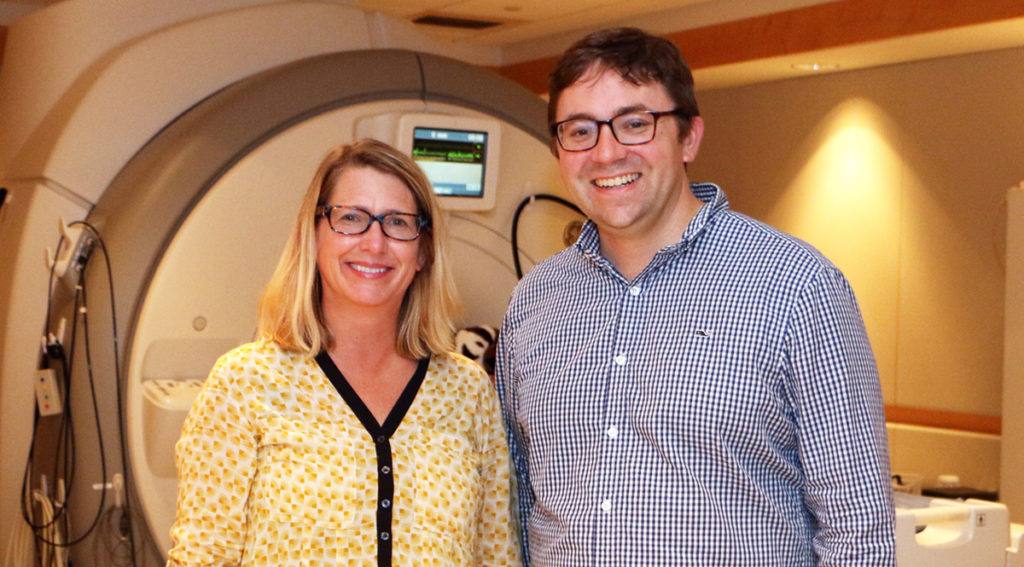
The University of Wisconsin-Madison will be one of 25 sites to study early brain and behavior development and the impact of early exposure to substances – such as opioids – and social stressors in infants and young children. The new initiative, HEALthy Brain and Child Development (HBCD) Study, is led by the National Institute on Drug Abuse and funded by 10 institutes and offices at the National Institutes of Health and the Helping to End Addiction Long-termSM Initiative of the National Institutes of Health (NIH HEAL InitiativeSM). The Wisconsin site will be led by Douglas Dean III, PhD, assistant professor of pediatrics and medical physics and Julie Poehlmann-Tynan, PhD, Dorothy O’Brien Professor of Human Ecology.
Much is still unknown about how a child’s developing brain is impacted by the influence of adverse environments. The HBCD Study will establish a large cohort of pregnant people and follow them and their children for at least 10 years. Findings from this cohort will provide a template of typical neurodevelopment in order to assess how prenatal and perinatal exposures to substances and environments may alter developmental trajectories. This research infrastructure can also be leveraged for urgent health needs, such as the current impact of the COVID-19 pandemic on development, or future health and environmental crises.
“It’s a landmark study for furthering what we know about infant brain development and behavioral development, especially in the context of risk,” says Poehlmann-Tynan.
The longitudinal study will collect data on pregnancy; infant and early childhood structural and functional brain imaging; body measurements; medical history; family history; biospecimens; and social, emotional and cognitive development. Knowledge gained from this research will help identify factors that confer risk or resilience for known developmental effects of prenatal and postnatal exposure to certain drugs and environmental exposures, including risk for future substance use, mental disorders, and other behavioral and developmental problems.
Dean’s work at UW-Madison focuses on brain imaging using magnetic resonance imaging (MRI) techniques to study early brain development. Meanwhile, Poehlmann-Tynan studies early childhood development in a family context, especially under conditions of risk. “It’s super exciting to combine our expertise in infants and young children and families, and also the brain development piece,” says Poehlmann-Tynan. Both investigators were part of the planning stage of the project that was a cross-campus collaborative effort that included Andy Alexander, PhD, professor of medical physics and psychiatry, Pilar Ossorio, PhD, professor of law and bioethics, Elizabeth Planalp, PhD, assistant scientist at Waisman Center, Viji Easwar, PhD, assistant professor of communication sciences and disorders, Ellen Goldstein, PhD, assistant scientist in the Department of Family Medicine and Community Health, Steve Kecskemeti, PhD, scientist at Waisman Center, Ryan McDonald, MD, assistant professor of obstetrics and gynecology, and Florence Hilliard, study manager in the Department of Family Medicine and Community Health.
This award is part of the Phase II HBCD Study, in which a fully integrated, collaborative infrastructure will support the collection of a large dataset that will enable researchers to analyze brain development in opioid-exposed and non-drug-exposed infants and children across a variety of regions and demographics.
Studies in early childhood development, says Dean, have been limited by the small sample size. The nature of this project – big sample size and participation of multiple sites – “is going to generate a lot of new knowledge about early brain and behavior development,” says Dean.
Upon collection, the data will become publicly available, which will allow for new projects examining important questions about brain and behavior development, says Dean.
This information, in addition to providing a reference on brain development for researchers and clinicians, may also provide insight into ways to reduce the impact of opioids and other substance use on development.
Longitudinally, HBCD also aims to understand the impact of growing up in the presence of adverse environmental exposures, such as drugs, stress, or COVID-19. The knowledge produced by HBCD may help inform policy formation and guide the development of interventions to reduce the neurodevelopmental effects of adverse environments.
During the COVID-19 pandemic, there has been an increased use of opioids, methamphetamines, alcohol, and THC in the general population. Additionally, many people who are pregnant or have young children have been stressed and isolated, says Poehlmann-Tynan. “It’s also a really important study that’s looking at the interaction of different kinds of exposures along with a child’s emerging social and emotional development. It is also looking at their brain development and understanding those pieces at this time when we’re still in the middle of a worldwide pandemic. It’s extremely timely.”
The Wisconsin study will be a collaborative effort and include the Department of Pediatrics, School of Human Ecology, the Office of the Vice Chancellor for Research and Graduate Education, the Morgridge Institute for Research, and the Waisman Center, which will provide the facilities and instrumentation for data collection. “The project would be very difficult to do without the kind of the infrastructure that we have at Waisman,” says Dean. “Having the research core and imaging facilities all under one roof, I think it’s going to make it a really nice way to bring families in [to participate in the study].”
Article written by:
Charlene Rivera-Bonet, Science Writer, Waisman Center
October 6, 2021